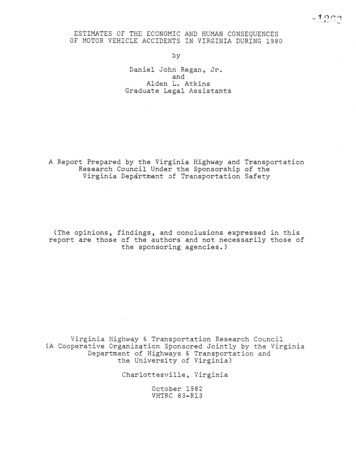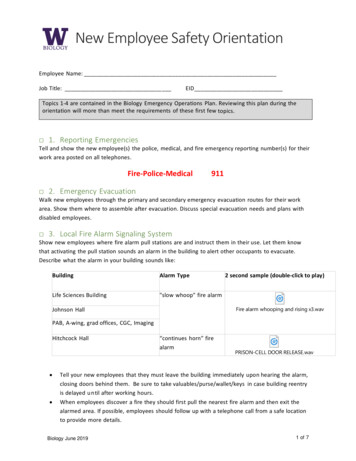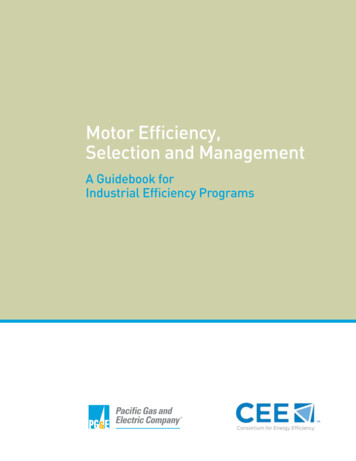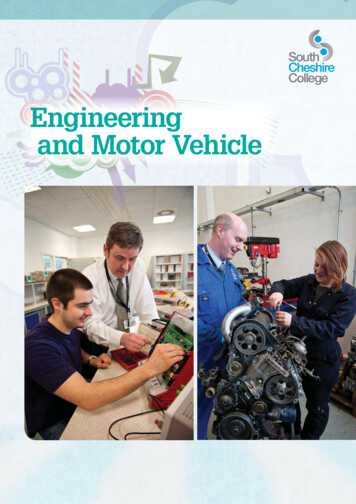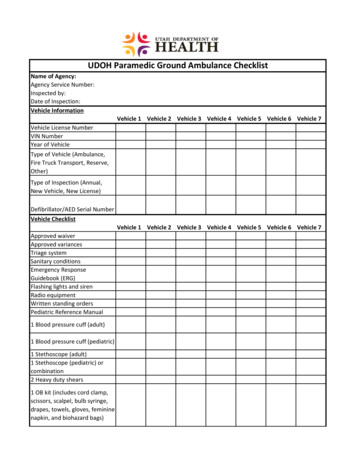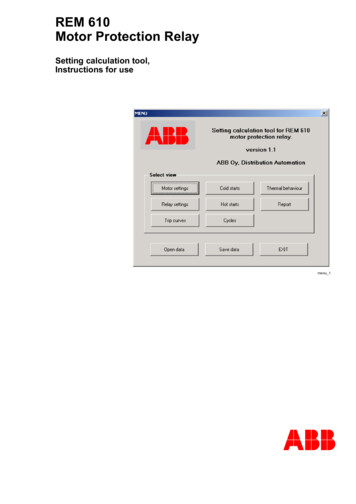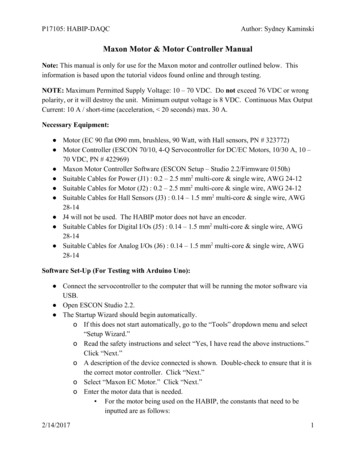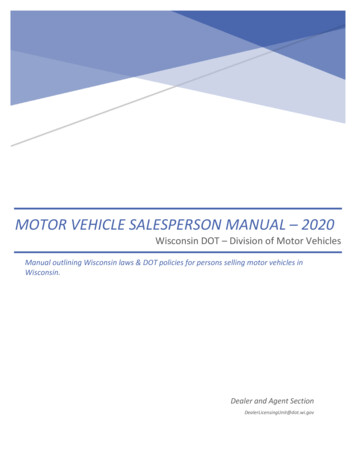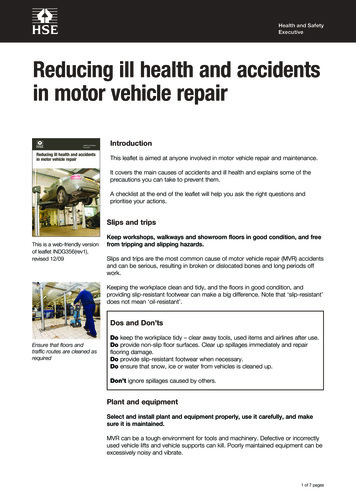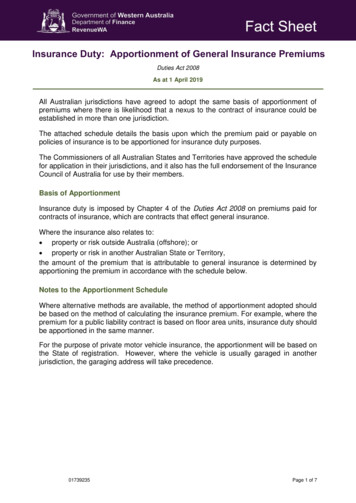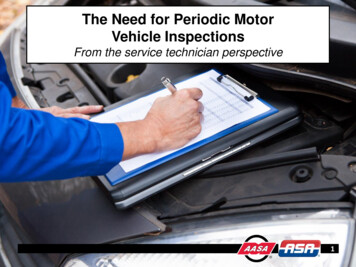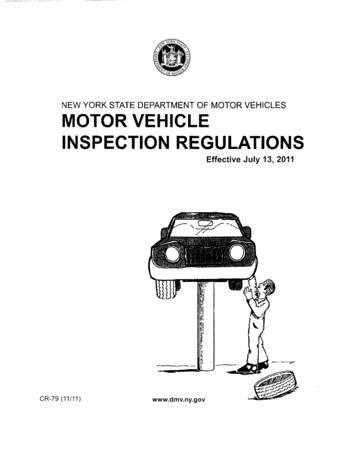
Transcription
Response to Motor VehicleAccidents InvolvingHazardous or UnknownMaterials Spills/s/ Brian Gibney9/14/16Motor Vehicle Accidents (MVA) involving petroleum and chemical spills, and spills of unknownnature, present challenging scenarios and environments in which Department employees mustperform their duties. These accident scenes can be chaotic, stressful and potentially dangerous.Usually, there are multiple agencies involved and diverse emergency response activities occurringsimultaneously. This document provides recommended safety measures for Department forcesresponding to an MVA involving such a spill, consistent with NYS Department of Labor, PublicEmployee Safety and Health (PESH) regulations, DOT safety and health standards, and NYSDOT/ NYSDEC MOU (#AM06352). Operating within the scope of these responsibilities will helpprotect the safety of DOT employees, and contribute to a timelier, efficient resumption of highwayoperations.Hazardous materials are substances with one or more of the following characteristics:-Substances/materials determined by the U.S. Secretary of Transportation to pose potentialhealth risk.Chemical substances (solid, gas, or liquid) toxic to humans; unprotected exposure to thesechemicals may result in severe illness.Dangerous goods or restricted articles that represent a hazard unless properly identified,classified, packed, and labeled per valid Dangerous Goods Regulations.Particles/substances capable of posing significant risk to health, safety or property whentransported.GENERAL RULESScene Safety: DOT supervisors arriving at an MVA are first responsible for ensuring their ownpersonal safety and the safety of subordinates and co-workers, and only after that for the safety ofothers at the scene. Supervisors shall not enter the immediate area of an accident scene or allowtheir subordinates to approach an MVA if uncertain that the area is safe due to spills of hazardousor unknown materials.
9/14/20162Response to Motor Vehicle Accidents Involving Hazardous or Unknown Materials SpillsCommunication: When approaching an MVA, employees in Department vehicles or equipmentshould pull onto the shoulder and use vehicle warning/hazard lights to alert approaching motorists.If it is not possible or safe to park on the shoulder, employees should drive past the accidentscene (if possible), and as soon as it is safe to do so, stop to report the accident as describedbelow.Employees who discover any MVA (including those involving a spill) shall as appropriate: Call 911: For all life threatening and other immediate emergencies involving police, fireand rescue, if DOT forces are first on scene.Identify and establish contact with the Incident Commander, if DOT forces are not first onthe scene. If Incident Commander has not yet arrived or been designated, identify andcontact upon arrival/designation.Notify immediate supervisor. It is generally a supervisory/management function to notifythe Transportation Management Center (TMC) and other necessary Regional resourcesand the Department of Environmental Conservation (DEC).For MVA’s involving suspected hazardous materials spills, employees shall, consistentwith their training, use the most current USDOT “Emergency Response Guidebook” toaccurately identify and report materials involved directly to Chemtrec 1-800-424-9300; ornotify the TMC, which in turn will call Chemtrec.Chain-of-Command: It is important for Department employees to work within the DOT RegionalChain-of-Command at all MVA scenes. Department employees shall always answer to DOTsupervision/management. However, initially other responding agencies may have more immediatefunctions and exercise more or total control over an accident scene. In general, police agencieswill act as Incident Commanders at scenes with possible criminal activities and/or fatalities; firedepartments at scenes involving fire/extrication; emergency medical services at scenes withserious injuries; and DEC for hazardous or unknown material spills. In many cases, more thanone of these scenarios may exist, and an on-scene decision regarding incident command will berequired. In some cases, responsibility may be shared. It is imperative that DOT forces identifyand establish communication with the Incident Commander on scene as soon as possible.DEPARTMENT RESPONSIBILITIESUnder the law most spills are cleaned up by the responsible party (owner of the contents) underoversight of DEC. When the responsible party is unknown, unwilling, or unable to do so, DEC willcall a standby contractor, pre-approved by DEC for such work. Often the location/nature of thespill will require DOT management to coordinate closely with DEC, and use resources to assist asfollows:Traffic Control: DOT will be responsible for providing traffic control, if on scene. It is not alwaysthe case that DOT forces are on scene, for example spills of lesser quantities, non-hazardousmaterials, and those not affecting traffic movement (within ROW, but off pavement/shoulder). Insome cases, DOT is not even notified at the time of the accident, and unaware until substantially
9/14/20163Response to Motor Vehicle Accidents Involving Hazardous or Unknown Materials Spillslater. DOT forces who arrive after others have established traffic control procedures shall assumeresponsibility and/or assist as necessary existing resources. The Resident Engineer or designeeshall coordinate with DEC and police regarding length of time needed to provide proper, effectiveclean-up and other response activities. DEC will provide guidance on safe distances for traffic atspills of hazardous or unknown substances.Spill Containment: For spills of hazardous or unknown materials, or at spill locations with knownpetroleum products, upon request of DEC, DOT may provide passive containment measures at adistance deemed safe. Such measures typically include depositing materials to preventcontaminated runoff from entering catch basins, streams or wetlands. However, it is important torecognize that the extent of assistance is directly proportionate to the degree of hazard posed.Spill Clean-Up: In the absence of the owner/operator, the proprietary responsibility for clean-upand removal of hazardous materials shall be by a DEC-approved standby contractor. Uponrequest of DEC, DOT will spread sand and/or absorbent on spills of known petroleum products(known to be harmless in small quantities, such as diesel fuel). Clean up by DOT forces shall beperformed only as a last resort and in consultation with DEC (if on scene), but only at direction ofDepartment management (typically, Resident Engineer or Assistant).Spill Clean-up by DOT forces may be permitted when: The spill is of a product known to be non-hazardous.The spill is a petroleum product, typically diesel fuel or engine oil, released as the result ofthe MVA, or a known non-hazardous waste material.Removal is performed in consultation with DEC.Clean-up involves absorbents or absorbent pads and/or removal by dry broom ormechanical broom.Employees are properly trained and use appropriate personal protective equipment (PPE).Spill Clean-up is prohibited when: The spill involves known hazardous material(s) or unknown substance(s).The spill is of a petroleum or hazardous waste product from the container(s), cargo tank(s)and/or from transport hoses and lines related to the cargo.Employees lack appropriate PPE and/or training.Chemicals are required to clean up the spill.Additional Work Practices: It is impossible to anticipate the nature of each responserequiring DOT involvement. However, as a general rule, Department employees should onlyclean up ROW spills that are of a similar nature/type to those that might occur at Departmentfacilities, using the following work practices: All vehicle engines operating in the immediate spill area shall be turned off.
9/14/20164Response to Motor Vehicle Accidents Involving Hazardous or Unknown Materials Spills Smoking is prohibited.Hand-to-mouth transfer from eating, drinking, etc. shall be avoided; drinking water andfood shall be kept away from the spill.The spill shall not be washed down drains or drop inlets.Only as permitted by DEC (if on scene), small quantities of material-contaminated sand orabsorbent may be dry-broomed to the side of the road; and/or picked up by shovel andplaced in a properly labeled waste container. If DEC is not on scene, DOT managementwill have to make those decisions unilaterally. At DEC direction, large quantities may beswept and collected by self-propelled sweepers.Avoid walking on the spill surface and sweep absorbent to the center of the spill area.If road is still wet after first application of absorbent, apply a second treatment.Employee debriefing may be appropriate after response.Clean-Up RationaleDOT managers shall “err on the side of safety” when deciding whether to clean up nonhazardous waste or petroleum products, and whether Department resources can be safelyemployed to quickly and decisively improve public safety. For example, spills requiringemployees to broom clean 100 (5 lb.) bags of absorbent should be considered beyond DOTcapacity; however, it may be reasonable to consider clean up with the same amount ofabsorbent using a self-propelled sweeper.Diesel fuel, gasoline or petroleum product clean-up shall be limited to fuel tank(s) and enginespills. It may not be appropriate for DOT forces to clean up spills from fully loaded, larger fueltanks (like buses and over-the-road trucks).Storage: The first priority is to remove spill clean-up materials directly to a disposal facility using aDEC-approved standby contractor. If not feasible, the Resident Engineer or designee will assistDEC in determining an appropriate location.PERSONAL PROTECTIONHeadEyeHandBodyFeetDepartment-approved hard hat.Safety glasses or goggles designed to prevent splashes, portable eyewash.Petroleum-resistant gloves (disposable nitrile rubber preferred - - - not latex).Department-approved high-vis apparel; if available, disposable coveralls shouldbe worn under high-vis apparel.Department-approved safety footwear, covered with disposable booties or oilresistant over-boots.If non-hazardous materials contact skin, thoroughly wash using soap and water. Change clothingif necessary to avoid further contact.
9/14/20165Response to Motor Vehicle Accidents Involving Hazardous or Unknown Materials SpillsTRAININGDepartment employees shall receive Hazard Communication/Right-to-Know training as requiredby OSHA/PESH. Training shall include a discussion on Material Safety Data Sheets for diesel fueland motor oil, and appropriate clean up techniques for cleaning spills considered small and limited(incidental).Department employees shall also receive Emergency Response training at the first responderlevel, including how to use the USDOT “Emergency Response Guidebook”, how to report MVA’swith spills, and the contents of this Safety Bulletin.HEALTH EFFECTS FOR DIESEL FUEL (most commonly spilled material)Inhalation (Breathing) - Excessive exposure may cause irritation to nose, throat, and respiratorysystem. Other effects may include headache, dizziness, loss of balance and coordination. Cleanup of small petroleum spills generally will not result in excessive exposure; however unusualcircumstances such as high pavement temperatures may result in higher airborne concentrations.Department employees experiencing any symptoms or noticing symptoms in others should notifysupervision immediately.Ingestion - The major health threat of ingestion occurs from aspiration - - - breathing liquid dropsinto the lungs. Aspiration may result in chemical pneumonia (fluid in the lungs), severe lungdamage, and respiratory failure. Ingestion may cause nausea, vomiting and diarrhea, and nervoussystem effects.Eyes - Contact with liquid or vapors may cause mild irritation. Flush eyes with water for 15minutes.Skin - Repeated and prolonged contact may cause irritation. Fuel may be absorbed through skin iflarge body areas are repeatedly exposed.REFERENCESDOT / ENCON MOU (#AM06352)USDOT “Emergency Response Guidebook”OSHA 29 CFR 1910.120 and 1200Petroleum Bulk Storage Regulations, 6NYCRR Parts 612-614Environmental Handbook of Transportation OperationTransportation Maintenance Safety ManualSpill Prevention, Control and Countermeasures (SPCC) Plans
Spill Clean-up by DOT forces may be permitted when: The spill is of a product known to be non-hazardous. The spill is a petroleum product, typically diesel fuel or engine oil, released as the result of the MVA, or a known non-hazardous waste material. Removal is performed in consultation with DEC.
